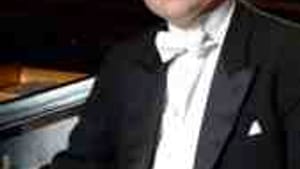Stay in the Loop
BSR publishes on a weekly schedule, with an email newsletter every Wednesday and Thursday morning. There’s no paywall, and subscribing is always free.
Making a guest appearance as conductor laureate and piano soloist with the Chamber Orchestra of Philadelphia, Ignat Solzhenitsyn played (and conducted) a performance of Mozart's 20th Piano Concerto that could have been billed appropriately as "Solzhenitsyn Plays Mozart "“ With Extra Bonus Material!"
First of all, Solzhenitsyn played Beethoven's cadenzas for Mozart's first and third movement. Beethoven revered Mozart's 20th Concerto, but he showed his respect not by imitating Mozart's style but by giving the best of his own from around 1809"“ music from a completely different musical planet than the one inhabited by Mozart, who died in 1791.
If you're a purist who believes that Mozart needs no improvement, these cadenzas will probably bother you. But you would have been annoyed even more by Solzhenitsyn's approach to the second movement.
"'Make something up'
Back in the days when I attended musicological conferences, there was much debate about how literally one should take Mozart's notation, especially in his concertos. Are we to take what Mozart wrote as sacrosanct, or is his melodic line just a suggestion?
There is of course no way to definitively prove either side of the argument. Through most of my life, though, the purist view has dominated; outside of cadenzas or the few places where Mozart basically says, "Make something up here," performers have for the most part played exactly what's written on the page.
Recently, though, many performers have taken Mozart down off his Classical pedestal and played his music with passion and abandon— as in, for example, Hélène Grimaud's recently-released fiery recording of the A minor Piano Sonata, K. 310. It's about time, as far as I'm concerned. The idea of the Standard Repertory, of Urtext editions, of there even being a Classical era that we're supposed to primly revere, are all relatively modern concepts that would have been incomprehensible to Mozart.
Time-travel to Vienna
I like to imagine time-traveling to Vienna in the 1780s to hear Mozart play his own piano concertos. Once you got acclimatized to the technical shortcomings of 18th-Century instruments, I suspect you might be astonished to find how close Mozart's renditions of his own music came to classical jazz of the mid-20th Century— in spirit if not in actual content.
That certainly seems to be Solzhenitsyn's view. Much of what he played in the second movement isn't in Mozart's score— and, to my ears at least, it all sounded tasteful, imaginative and genuinely spontaneous. Solzhenitsyn gave a convincing and vital reading of the concerto's outer movements as well.
The rest of the concert"“ an extraordinary homage to Bela Bartok by Witold LutosÅ‚awski, and Haydn's Symphony No. 103"“ was beautiful music, beautifully played. I hadn't heard the Chamber Orchestra since Solzhenitsyn's departure after the 2008-2009 season and in fact attended this concert only because some tickets fell into my lap through the generosity of friends. It was a delight to see that the group has retained most of its personnel and plays with the same joy and finesse that gave me so much pleasure a few years ago.♦
To read another review by Tom Purdom, click here.
First of all, Solzhenitsyn played Beethoven's cadenzas for Mozart's first and third movement. Beethoven revered Mozart's 20th Concerto, but he showed his respect not by imitating Mozart's style but by giving the best of his own from around 1809"“ music from a completely different musical planet than the one inhabited by Mozart, who died in 1791.
If you're a purist who believes that Mozart needs no improvement, these cadenzas will probably bother you. But you would have been annoyed even more by Solzhenitsyn's approach to the second movement.
"'Make something up'
Back in the days when I attended musicological conferences, there was much debate about how literally one should take Mozart's notation, especially in his concertos. Are we to take what Mozart wrote as sacrosanct, or is his melodic line just a suggestion?
There is of course no way to definitively prove either side of the argument. Through most of my life, though, the purist view has dominated; outside of cadenzas or the few places where Mozart basically says, "Make something up here," performers have for the most part played exactly what's written on the page.
Recently, though, many performers have taken Mozart down off his Classical pedestal and played his music with passion and abandon— as in, for example, Hélène Grimaud's recently-released fiery recording of the A minor Piano Sonata, K. 310. It's about time, as far as I'm concerned. The idea of the Standard Repertory, of Urtext editions, of there even being a Classical era that we're supposed to primly revere, are all relatively modern concepts that would have been incomprehensible to Mozart.
Time-travel to Vienna
I like to imagine time-traveling to Vienna in the 1780s to hear Mozart play his own piano concertos. Once you got acclimatized to the technical shortcomings of 18th-Century instruments, I suspect you might be astonished to find how close Mozart's renditions of his own music came to classical jazz of the mid-20th Century— in spirit if not in actual content.
That certainly seems to be Solzhenitsyn's view. Much of what he played in the second movement isn't in Mozart's score— and, to my ears at least, it all sounded tasteful, imaginative and genuinely spontaneous. Solzhenitsyn gave a convincing and vital reading of the concerto's outer movements as well.
The rest of the concert"“ an extraordinary homage to Bela Bartok by Witold LutosÅ‚awski, and Haydn's Symphony No. 103"“ was beautiful music, beautifully played. I hadn't heard the Chamber Orchestra since Solzhenitsyn's departure after the 2008-2009 season and in fact attended this concert only because some tickets fell into my lap through the generosity of friends. It was a delight to see that the group has retained most of its personnel and plays with the same joy and finesse that gave me so much pleasure a few years ago.♦
To read another review by Tom Purdom, click here.
What, When, Where
Chamber Orchestra of Philadelphia: Mozart, Piano Concerto No. 20 in D Minor, K. 466; Lutoslawski, Funeral Music; Haydn, “Drum Roll†Symphony No. 103 in E-flat Major. Ignat Solzhenitsyn, pianist and conductor. March 5, 2011 at Perelman Theater, Kimmel Center for the Performing Arts. (215) 545-1739 or www.chamberorchestra.org.
Sign up for our newsletter
All of the week's new articles, all in one place. Sign up for the free weekly BSR newsletters, and don't miss a conversation.
 Dan Coren
Dan Coren
